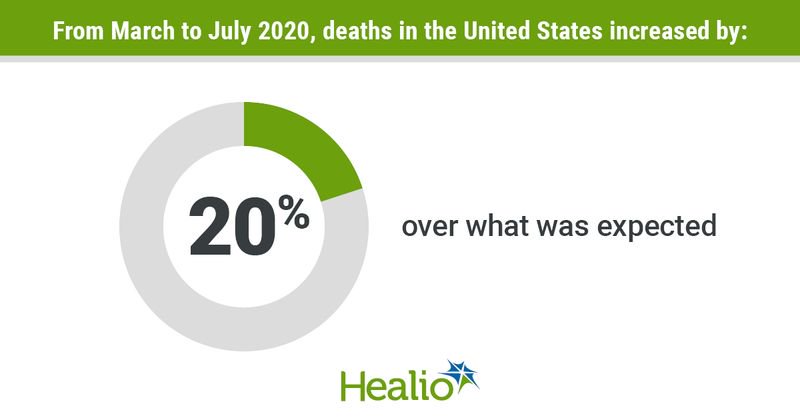Deaths spike 20% in U.S. during 4-month period
The United States had a mortality rate that was 20% higher than expected between March and July, and it experienced high COVID-19-related mortality and excess all-cause deaths into September, according to results from two JAMA studies.
The first study explored excess deaths and their relationship to states’ reopening and easing of restrictions.

“The number of deaths that are occurring as a result of the pandemic is larger than the COVID-19 death count that is being reported,” Steven Woolf, MD, MPH, director emeritus of the Center on Society and Health at Virginia Commonwealth University, told Healio. “Some of that excess is being produced by people who are dying from causes other than COVID-19 but from disruptions produced by the pandemic itself and our response to it.”
Woolf explained that some of the excess deaths occurred in people with acute emergencies that went untreated, those with chronic diseases whose conditions deteriorated, and patients with mental health or substance abuse problems that were exacerbated by the pandemic.

Woolf and colleagues analyzed death counts between March 1 and Aug. 1, obtained from the National Center for Health Statistics. They defined COVID-19 deaths as those in which COVID-19 was cited as either a contributing or underlying cause. Data related to non-COVID-19-related deaths were included only for Alzheimer’s disease, heart disease and 10 other grouped causes. They also used a progression model to calculate expected death counts based on historic norms.
A total of 1.3 million deaths occurred in the U.S. during the study period — a 20% increase compared with the expected death rate (95% CI, 1,110,364-1,111,697). Approximately 67% of the 225,530 excess deaths were directly attributed to COVID-19.
Woolf said provisional data are being released at a rapid pace and should be carefully analyzed.
“The death counts that we are getting from the states are being rushed out by the CDC because of the public health emergency, and you have to take those numbers with a grain of salt,” Woolf said. “In our field, we're accustomed to waiting 1 to 2 years before we can get reliable vital statistics.”
In a separate study, Alyssa Bilinski, MSc, a health policy PhD candidate at Harvard University, and Ezekiel J. Emanuel, MD, PhD, vice provost for global initiatives at the University of Pennsylvania, compared COVID-19 deaths and excess all-cause mortality in the U.S. with that of 18 other countries.
“The U.S. has experienced more deaths from COVID-19 than any other country and has one of the highest cumulative per capita death rates,” the researchers wrote. “An unanswered question is to what extent high U.S. mortality was driven by the early surge of cases prior to improvements in prevention and patient management vs. a poor longer-term response.”
They calculated the COVID-19 per capita mortality rate and grouped countries by mortality — low if the rate was below five per 100,000, moderate for five to 25 per 100,000 and high for more than 25 per 100,000.
By Sept. 19, the U.S. had a COVID-19 mortality rate of 60.3 per 100,000 — more than countries with low or moderate mortality but similar to other high-mortality countries like Italy (59.1 per 100,000) and Belgium (86.8 per 100,000). If the U.S. death rate was comparable to that of Australia, the U.S. would have had 187,661 fewer COVID-19 deaths, the researchers explained.
Although the U.S. had a lower COVID-19 mortality rate than high-mortality countries during the early spring, after May 10, all six high-mortality countries had fewer deaths per 100,000 than the U.S. For example, between May 10 and Sept. 19, Italy’s death rate was 9.1 per 100,000, whereas the U.S. had a rate of 36.9 per 100,000. If the U.S. had a death rate comparable with most high-mortality countries beginning May 10, it would have had 44,210 to 104,177 fewer deaths.
In the 14 countries with all-cause mortality data, the same pattern found in COVID-19-specific deaths was similar for all-cause mortality, according to the researchers.
“After the first peak in early spring, U.S. death rates from COVID-19 and from all causes
remained higher than even countries with high COVID-19 mortality,” Bilinski and Emanuel wrote. “This may have been a result of several factors, including weak public health infrastructure and a decentralized, inconsistent U.S. response to the pandemic.”
Woolf said that “mortality is only one measure of health,” and that long-term consequences of the virus will take time to come to the forefront.
“Excess mortality from the pandemic is going to unfold over a period of time. Right now, we can only look at deaths that have happened immediately, but we know from the kinds of diseases that we're talking about that some people may be dying 1, 2 or 3 years from now because of problems that were set into motion during the pandemic,” he said.
References:
- Bilinski A, et al. JAMA. 2020;doi:10.1001/jama.2020.20717.
- Woolf SH, et al. JAMA. 2020;doi:10.1001/jama.2020.19545.

